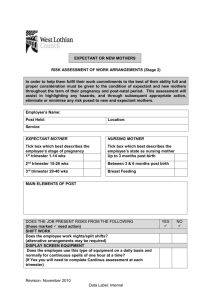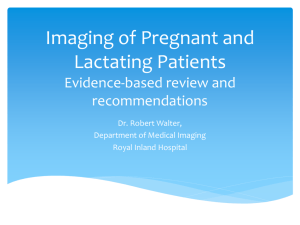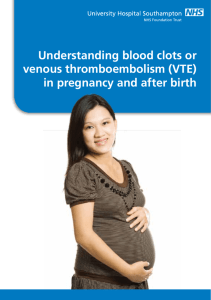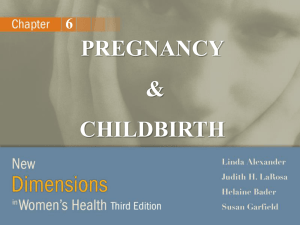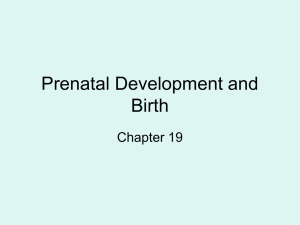DVT and Pregnancy
advertisement
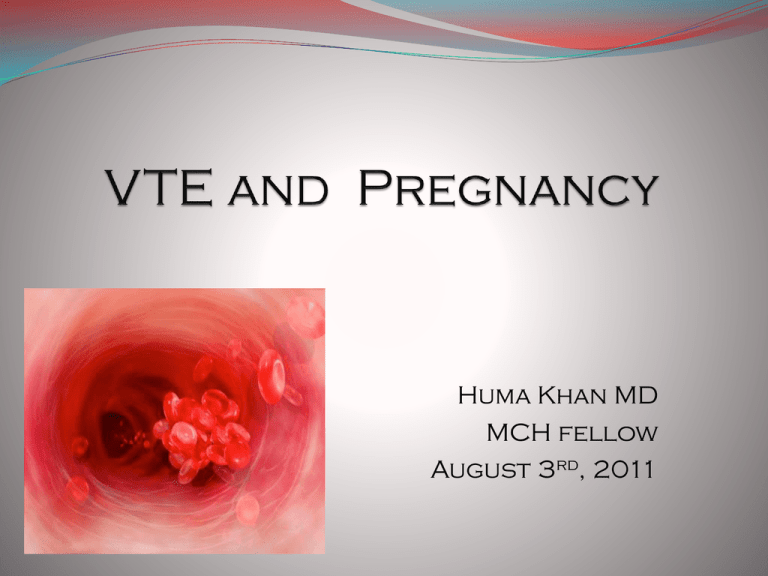
Huma Khan MD MCH fellow August 3rd, 2011 Epidemiology of VTE in pregnancy to be able to identify the causes of vte To understand and identify the different diagnostic tools Understand prenatal management To be aware of the different pharmacotherapies Identify risk factors for post natal management AK is a 24 yr old obese AA G2P0010, who comes for an initial prenatal visit. She is very sure of her lmp which places her at about 8wk 3d GA. She states this a planned pregnancy and that she has been taking pnv’s. Pmhx: DVT in her left leg 4yrs ago, Pshx: none Meds: pnv Fhx: DM, cHTN Shx: married, employed, no smoking, no etoh, hx of thc in college with occasional addition of other substances which she denies using once she graduated Obhx: SAB 2 yrs ago at 6 wks different partner VTE( DVT & PE) occurs in 5 -12 per 10,000 pregnancies Postpartum 3 -7 per 10,000 deliveries 7-10 fold increase in antepartum 15- 35 fold in post partum PE leading cause of death in developing countries current deaths from PE: 1.1 -1.5 per 100,000 deliveries Venous stasis Vascular damage hypercoagulabil ity Virchow's triad Venous stasis: 1st trimester to 36wk Progesterone induced venodilation Right iliac artery over left iliac vein Gravid uterus Immobilization Virchow's triad Vascular damage: Compression at delivery Assisted or operative delivery Hypercoagulability: procoagulant factors anticoagulant activity fibrinolytic activity = more thrombin generation + less clot dissolution black race Smoking Heart disease Multiple pregnancy Sickle cell disease Ama Diabetes Obesity ( BMI > 30) Lupus C-section( especially emergent or after long labor) disorder of hemostasis predisposing to thrombotic event Inherited Factor V Leiden Prothrombin G20210A Acquired Antiphospholipid antibody syndrome Lupus anticoagulant cause 50 % of VTE in pregnancy Occur only in 0.1% of pregnancies Universal screening not cost effective Screening affected in pregnancy protein S levels fall in 2nd trimester Massive thrombus & nephrotic syndrome decrease antithrombin levels Liver disease decrease protein C & S levels Screening should be done after pregnancy and when no longer taking anticoagulants Complications Early and late losses IUGR Placental abruption Difficult to differentiate from pregnancy sx’s DVT: Unilateral leg pain and swelling, especially left leg ≥ 2 cm calf circumference difference 1st trimester Homan’s sign Dresand et al. aafp,77:1709-16, 2008 VCUS ( venous compression ultrasonagraphy) Sensitivity : 89 - 97% Specificity : 94 - 99% Less accurate for isolated calf and iliac vein thrombosis D-Dimer Levels increase during pregnancy Usually positive and hence of little use Negative test with low clinical probability has a NPV of 99.5 % when highly sensitive assay used. positive test sensitivity is 100% & specificity is 60% hence additional testing is needed MRI and ct can be done in high probability pts Difficult to differentiate from pregnancy sx’s PE: Dyspnea Chest pain Unexplained tachycardia Dresand et al. aafp,77:1709-16, 2008 v/q scan PPV when combined with high clinical pretest is 96% Only 56% with low clinical pretest Radiation dose : 0.003 -.077 mGY ct In one study PPV’s in Lobar: 97% segmental:68% Subsegmental: 25% False positive rates: 30% , detected incorrectly in segmental/ subsegmental Radiation dose: 0.02 -0.06 gy AK is a 24 yr old obese AA G2P0010, who comes for an initial prenatal visit. She is very sure of her lmp which places her at about 8wk 3d GA. She states this a planned pregnancy and that she has been taking pnv’s. Pmhx: DVT in her left leg 4yrs ago, Pshx: none Fhx: DM, cHTN Meds: pnv Shx: married, employed, no smoking, no etoh, hx of thc in college with occasional addition of other substances which she denies using once she graduated Obhx: SAB 2 yrs ago at 6 wks different partner On further examination you find BP: 140/85 BMI of 32 A few varicose veins on her right calf On US she is 10wk with twin gestation Identify the risk factors prenatal management What do do during labor and delivery Identify risk factor for post partum management Rcog Green- top guideline 37, 2009 prophylaxis in pregnancy Marik & Plante nejm,359:2025-33, 2008 Therapeutic dosing in pregnancy Vena caval filters Marik & Plante nejm,359:2025-33, 2008 LMWH UFH More predictable dose Dose dependent response response More dose independent mechanisms of clearance Long plasma half life Once or twice daily dosing No lab visits Lower risk of bleeding, HIT & fractures Not easily reversed Clearance is dependent on renal / liver function Half life is short and dose dependent Multiple dosing Labs for PLTS High risk of bleeding and HIT Easily reversed by protamine sulphate Crosses placenta Increases miscarriage, stillbirth, embryopathy (midface hypoplasia,stippled epiphyses) if exposed in 1st trimester In 2nd and 3rd trimester causes CNS abnormalities and hemorrhage It is compatible with breast feeding Switch to UFH several wks before stop all anticoagulation with onset of labor If planned IOL or c-section then stop 24 hrs prior to Management varies based on prophylaxis /treatment doses neuroaxial anesthesia contra-indicated in spontaneous labor with full anticoagulation Spinal anesthesia placed 12 hrs after prophylactic dose of LMWH 24 hrs after therapeutic dose of LMWH 6 hrs after UFH dose and confirmed normal activated partial-thromboplastin time General preferred if emergent c-section Anticipate larger blood loss Bourjeily et al. lancet 375:500-12, 2010 Post partum thromboprophylaxis not routinely indicated ASA not used Thromboprophylaxis for 6-12 wks Warfarin can be used Incidence of PE higher by a factor of 2.5 to 20 Incidence of fatal PE by a factor of 10 Thromboprophylaxis highly effective in reducing the high incidence Duration is 3-7 days for intermediate risk Up to 6 wks for high risk. Rcog Green- top guideline 37, 2009
